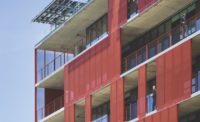Climate-Smart Shelter
Housing Case Studies

REBUS facade retrofit system. Photo © Agnete Achlichtkrull
RECORD looks at housing that addresses global warming and occupant well-being.
REBUS

Image © Henning Larsen
Henning Larsen Architects’ REBUS is a facade retrofit concept devised specifically for Danish social housing constructed in the 1960s and ’70s. There are nearly 134 million square feet of these aging buildings across Denmark. The reclad panels, which can be made either from steel or wood components, are designed to be fabricated off-site and installed over the existing facade while the apartments are still occupied, improving energy performance by at least 50 percent. Since almost all Danish social housing of this era was based on the same 300 millimeter (0.98 feet) spatial increment, the system can be easily adapted for use across the entire typology. Henning Larsen estimates that 56 REBUS renovations can be completed for the carbon price of one new building.
Joann Gonchar, FAIA
St. Peter Residential

Photo © Michael Mantese / Eskew Dumez Ripple
The first multi-family affordable housing project in Louisiana to target net-zero energy operations, the Eskew Dumez Ripple-designed project contains 50 one- and two-bedroom apartments for lower-income residents, with half reserved for veterans. A combination of active and passive strategies should help St. Peter reach its net-zero goal, including a very low energy-use intensity, the 450 solar panels on the roof, and a battery system adjacent to the parking lot. The battery lends the project added resilience by lessening dependence on the grid—when Hurricane Zeta swept through New Orleans in October 2020, causing widespread power outages throughout the city, St. Peter’s lights stayed on.
Pansy Schulman
Dekalb Commons

Image © Nightnurse Images / Magnusson Architecture and Planning
The 85-unit affordable housing complex, Dekalb Commons, consists of a pair of mid-rise buildings across the street from one another in Bedford-Stuyvesant, Brooklyn. Designed by Magnusson Architecture and Planning (MAP) and slated for completion in 2024, the all-electric complex of studio to three-bedroom apartments is targeting Passive House and Enterprise Green Communities certifications. It incorporates strategies for near net-zero operations, on-site renewable energy, and embodied carbon reduction. MAP is specifying “asthmagen-free” interior finishes, which means finding alternatives to materials commonplace in affordable housing, such as composite wood products that emit formaldehyde, PVC, and vinyl.
J.G.






